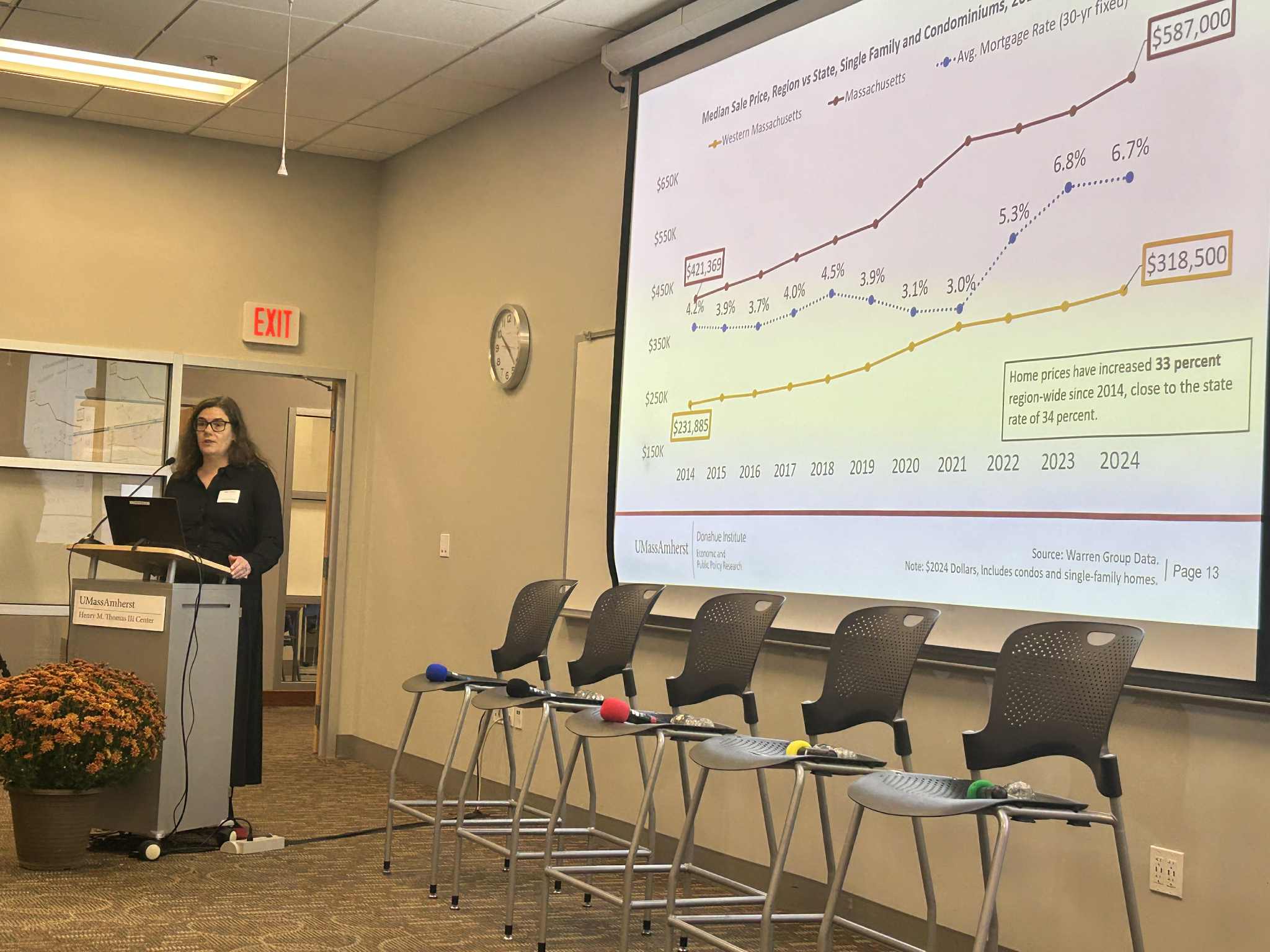University of Massachusetts Donahue Institute Senior Research Manager Kerry Spitzer presents information on housing in Western Massachusetts at the UMass Amherst Henry Thomas Center on Oct. 1.
Reminder Publishing photo by Ryan Feyre
SPRINGFIELD — A new study conducted by Way Finders and the University of Massachusetts Donahue Institute confirms that Western Mass. is facing a severe housing shortage across its four counties.
The 130-page study, which was conducted over the past year, reports housing conditions and opportunities across Hampden, Hampshire, Franklin and Berkshire counties, while simultaneously illustrating the impacts increased housing would have on the region.
According to the findings, Western Mass. is short about 23,420 units, as of 2025.
The dearth of housing is compounded by the burden of rising housing costs, which falls most heavily on the renters, according to the new report. In 2023, 36% of Western Mass. renters earned less than $25,000, meaning one in three households can only afford to pay $625 per month in rent.
However, the report states that not many apartments are available at that price. Between January 2021 and October 2024, rents in Berkshire and Hampshire counties increased 35% and rents in Hampden County increased by 40%, according to the Zillow Observed Rent Index.
“Massachusetts has underproduced housing as a state for decades,” said Mark Melnik, the director of the Economic & Public Policy Research group at the UMass Amherst Donahue Institute. “And the ramifications of that we see now are extremely high housing prices.”
The new report is the third one that the UMass Donahue Institute has worked with Wayfinders on, but this is the first time that all four counties are included, according to Kerry Spitzer, the senior research manager for the UMass Donahue Institute.
In her presentation to the public at UMass Amherst Henry M. Thomas III Center on Oct. 1, Spitzer confirmed that the demand for housing is exceeding the supply in Western Mass., as evidenced by the low vacancy rates in the region in terms of homeownership and rental units.
According to Spitzer, rising rents and increased housing prices are having a detrimental impact on demographics across the spectrum.
However, the report illustrates that Black and brown people and those experiencing low income are more likely to experience issues around housing cost per unit affordability.
Spitzer shared that a rise in eviction rates and the role of investors in short-term rentals is a result of these high prices.
The way to address these challenges: build more housing for all incomes and all sizes.
“When we look at the data, we estimate that by 2035 we’re going need an additional 17,000 housing units to meet current and future demand for housing in our region,” Spitzer said. “We need to build more homes, but we also need to rehabilitate homes, preserve existing housing, and really double down on making sure that we have enough housing for everybody in the region.”
Building and rehabilitating more housing in the region is only one part of the puzzle, according to Keith Fairey, the president and CEO of Wayfinders. In an interview with the media, Fairey said there are other economic factors.
For example, while the average housing prices in Western Mass. are seemingly more affordable than eastern Mass., there is a much lower concentration of higher wage industries in the west than there are in the eastern part of the state.
Fairey shared that eastern Mass. has a lot of life sciences and high-tech opportunities, while Western Mass. mostly specializes in service sector type jobs.
“Enhancing economic development opportunities is a nexus when we think about what the quality-of-life opportunities are for folks,” Fairey said. “So, it’s building more housing, but it’s also trying to develop other job opportunities for folks so that they are better able to afford housing.”
The report also underscores the need to fast track permitting across the state. According to Melnik, only 0.8 building permits per 1,000 residents are being issued throughout Western Mass. If the region was a state, it would rank last in the country.
The same issue can be stated for the entire commonwealth. Whereas the U.S. building permit average is 4.1 per 1,000 residents, Massachusetts is only seeing 1.7 permits per 1,000.
“You look at states like in the south and in the southwest, you’re seeing building permit levels upwards of seven or eight per 1,000,” Fairey said. “We have a long way to go in this commonwealth to really clear away the challenges around permitting, speed the process of building new housing units and rehabbing the housing units we have.”
Another key outcome of the study, according to Spitzer, is the impact seasonal tourism is having on housing in the region. She said while seasonal tourism is an integral part of a place like the Berkshires, some of the short-term rentals can take up units that might otherwise be available for those who need them all year.
“Seasonal tourism is a key part of the economy in the Berkshires, so that’s a positive thing,” Spitzer said. “But when you’re looking at it from a housing perspective, sometimes those short-term rentals can take up units that might otherwise be available for year-round residence.”
There is a silver lining to all these challenges, according to Spitzer. If the state were to reach the threshold of 17,000 additional housing units by 2035, the economic impact would be enormous. She said the development would lead to 76,000 jobs and $7.5 billion in potential economic impacts through net new economic activity in the region.
There are also other statewide initiatives, according to Fairey, like the bonding bill and increased resources to the state low-income housing credit, that are in the process of reducing red tape when it comes to housing development and helping residents find affordable options.
But progress doesn’t happen overnight, according to the researchers.
“These are things that take time,” Melnik said. “But I think to the extent in which we can move things faster is really important because we’ve gone too long with underproducing in Massachusetts.”



